 |
 |
 |
The Search By Liesl Clark and Jochen Hemmleb
Finding the Body In 1975, a Chinese climber named Wang Hongbao left his tent at Camp VI for a walk. He was gone for 20 minutes, during which time he came upon the body of a climber that he later described to a fellow climber as being an old "English dead" because of the vintage clothes he was wearing. No other English climber was known to have died at that elevation on Everest, so it is presumed this body could be that of either George Mallory or Andrew Irvine. Wang revealed his find only in 1979, during a Japanese expedition on Everest when he confided his story to a fellow climber. The very next day, he was killed in an avalanche, so no more is known about his find.
First, our team must locate the exact site where Wang was camping (the 1975 Chinese Camp VI site) and then fan out in a 10-minute walk radius from that point to conduct their search; because Wang was gone from his tent for 20 minutes, he could not have walked more than 10 minutes from his tent before finding the body. The site is off the beaten trail up Everest and covers an area of about 1,080 square feet. Located at about 27,000 feet, the search area is also known as the Snow Terrace. The moutaineers, led by Eric Simonson and under radio consultation with geologist Jochen Hemmleb, who will be watching the team by telescope from Base Camp, will go out on three different research tours as outlined by Hemmleb's "Research Manual". By studying photographs taken in the area and going over detailed orthophoto maps of Everest's upper North Face, Hemmleb has pinpointed the exact area in which the team should search for the body spotted in 1975. "When I saw photographs of various Camp VI locations, I realized that the background in each of those photographs was different. From these differences, I deducted a method of pointing out locations on Everest's North Face. It became clear that the Chinese Camp VI, where the body was found, was different from today's Camp VI. That is no theory—it's visible in the photographs." Now all the team needs to do is follow Hemmleb's directions to that site. The team plans to follow Hemmleb's manual for searching, first by exploring and photographing the locations, and then by taking a pass on the Snow Terrace with a metal detector, in case the body and camp site are covered with ice and snow. What metal would the device detect on Mallory and Irvine? Ice axes, nails on the soles of their boots, backpack frames, oxygen canisters, and the camera. If the camera is found, it will be transported, still frozen, to Kodak's labs in Rochester, New York, where the film will be processed and published on this Web site.
The Camera: Mallory (and also possibly Irvine) had a Kodak Vestpocket Model B Camera. Oxygen bottles: The bottles used in 1924 were larger than the bottles used in 1922 and longer and skinnier than those from the 1930s. Also, it is known that no bottles from the 1930s were left on the mountain higher than approximately 26,250 feet.
Equipment: Ice axes, nailed boots, frame backpacks, and maybe even crampons. Recreating Odell's Sighting Mallory and Irvine were last seen "going strong for the top" by Noel Odell, who was standing at 26,000 feet on the North Face, no more than 100 yards away from the crest of the North Ridge. Our camera crew plans to go to the point at which Odell thought he saw Mallory and Irvine climbing on the Second Step. We will try to recreate this sighting and film it with a 25mm lens, which is closest to the field of vision of a human eye. Our film will reveal whether it would have been possible for Odell to see Mallory and Irvine climbing the Second Step about 4,000 feet away. We will attempt to film climbers on the Second Step, from Odell's vantage point, to verify if the human eye could detect small figures moving so far away.
However, when studying Odell's first account of his sighting: "At 12:50 a.m. M & I on ridge nearing base of final pyramide."he appears to be referring to a point at or above the Second Step.
In trying to solve the mystery of Mallory and Irvine, there is little solid fact to go on. The only piece of hard evidence in this story is the ice axe found at 27,760 feet on Everest. It is believed the ice axe was Irvine's because it has hand-carved nick marks on it, which Irvine was known to make on his belongings. Our team will attempt to find the site of the ice axe, and mark it with GPS. (See Jochen Hemmleb's Research Manual. As far as is known, the body was found in 1975 about 800 feet directly below the ice axe.
Climbing the Second Step One of the great mysteries of Mallory and Irvine's summit day is whether or not they could have climbed the crux of the route, the so- called Second Step, a 100-foot high rock wall at 28,230 feet. The Chinese made the first confirmed climb of the Second Step in 1960. The following is a compilation from contemporary reports: "Liu Lienman tried four times to climb the 15-foot headwall, each time falling off exhausted. Qu Yinhua then took over the lead. Unable to scale it by any other means, he removed his gloves, shoes and socks to gain a better grip on the rock (later losing his toes and parts of his fingers to frostbite). Finally, by standing on Liu's shoulders and hammering in two pitons, Qu managed to get to the top of the cliff. With the help of a rope paid out from above, the three others followed."During the second ascent of Everest from the north side, in 1975, the Chinese carried up a ladder and fixed it upon the Second Step to aid the passage of the headwall. Since then, all climbers have used the ladder to surmount the Second Step.
Meet the Team 1999 | Forensics | The Camera (QTVR) | Research Manual Photos: (1,8) Liesl Clark; (2) Peace River Studios; (3) Courtesy of the John Noel Photographic Collection; (4) Finch Collection, courtesy of Mrs. Scott Russell; (5) From Everest: The Mystery of Mallory and Irvine, Arcturus Motion Pictures; (6) Courtesy of The Alpine Club; (7) Courtesy of Cellmark Diagnostics. Lost on Everest | High Exposure | Climb | History & Culture | Earth, Wind, & Ice E-mail | Previous Expeditions | Resources | Site Map | Everest Home Editor's Picks | Previous Sites | Join Us/E-mail | TV/Web Schedule About NOVA | Teachers | Site Map | Shop | Jobs | Search | To print PBS Online | NOVA Online | WGBH © | Updated November 2000 |

 The search team.
The search team.
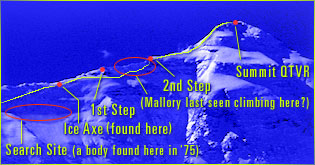
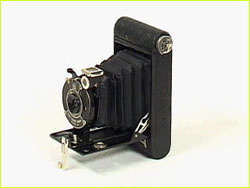 Kodak Vestpocket
Kodak Vestpocket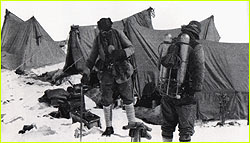 June 6, 1924: Mallory and Irvine leave the North Col for their final summit attempt.
June 6, 1924: Mallory and Irvine leave the North Col for their final summit attempt.
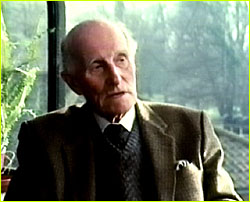 Noel Odell
Noel Odell
 Irvine's Ice Axe
Irvine's Ice Axe
 DNA testing could help unlock the mystery of Mallory and Irvine.
DNA testing could help unlock the mystery of Mallory and Irvine.
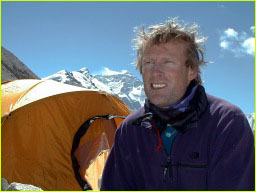 Conrad Anker
Conrad Anker